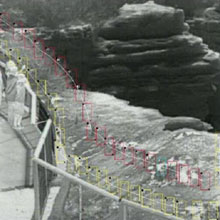Initial consultations with local people, mental health and crisis support agencies revealed that troubled individuals often spend several hours on the cliff tops before finally deciding to commit suicide, and that active intervention during this period might save life. Hence the council’s plan for reducing self-harm incidents, improving the area’s reputation and encouraging more visitors, included a video surveillance system to aid rapid police intervention by enabling critical incidents to be identified day or night.
Initially the project included restyling the park entries, erecting new inward curving fences along the cliff edge to deter climbing, as well as new seating and low level LED lighting to improve the ambience especially at night. New signs were installed as were two purpose-built, vandal-resistant telephone help points with autodialing for the charity Lifeline and the emergency services, together with automatic audio visual feeds and location ID. Four Bosch MIC 412 thermal PTZ cameras provided vision at night and in bad weather, at considerable distance and amongst vegetation.
With subsequent federal funding in 2011 came a GeViScopeHS/R with an expansion unit; new fixed view cameras to monitor the telephone help points; and five Moog ‘thermal & optical’ cameras for providing thermal and optical views at the same time.
Most cameras are concentrated near the entrances and along the cliff-top walk so that monitoring centre operators can help police with missing persons searches by identifying individuals as they enter or leave the park, and locating them if they remain in the park.
The remote operator only views the live video and assesses the situation when requested to do so by the police – i.e. when a member of the public has reported a possible incident, when there has been an emergency call from a help point, or following an alert from Lifeline. The operator can also review recorded footage for post-incident investigation but only with specific permission from the Council.
Justine Henderson, communications manager and spokesperson for Woollahra Council reports, “We know the footage has been useful to police in responding to potential on site emergencies as we’ve seen an increase in use of the monitoring provided by the camera system. At the start of the project the footage was being used for retrospective investigations and now it is being used more for direct interventions – which is a good result.”
Geutebruck video analytics (VMD) |
Analytics with thermal cameras
In autumn 2011 an extended trial using a selection of existing cameras was successful in establishing that Geutebruck video analytics (VMD) on thermal camera streams could accurately identify dangerous incidents and provide a reliable basis for alerting the emergency services.
The GeViScope’s VMD software was set up with two lines of alarm zones, one along the fence and one parallel on the seaward side. Time thresholds were used to pick up someone climbing over the fence, and an alarm was set to trigger immediately if a target moved from the first line of zones into the second line at the cliff edge.
The tests correctly identified incidents where individuals, or groups, breached the safety fence and ventured out to the cliff edge. Some people were clearly just making sight-seeing or thrill-seeking explorations but others seemed to have more troubled motivations. False alarms were minimal and proved very easy for operators to recognise and disregard.
 |
| The tests correctly identified incidents where individuals, or groups, breachd the safety fence and ventured out to the cliff edge |
In the light of this success Woollahra Council is seeking funding to add a small number of fixed view cameras to the video system to establish a permanent analytic detection ‘fence line’. This VMD option is substantially cheaper than ground-based radar and offers the advantage of combining video display, detection and verification all in one. With some dedicated fixed view cameras taking care of these core functions, the existing PTZ cameras would then be available to provide the operator with a wider view, more accurate details etc., without risk of disturbing the VMD function.
“Geutebrück Pacific’s entire team are particularity proud of this project,” says managing director, Anthony Brooks. “It’s very exciting to be applying this advanced technology outside the traditional security environment where it has the potential to deliver very positive outcomes for many individuals and their families. We can’t think of a more worthwhile and satisfying project.”
Learn why leading casinos are upgrading to smarter, faster, and more compliant systems













